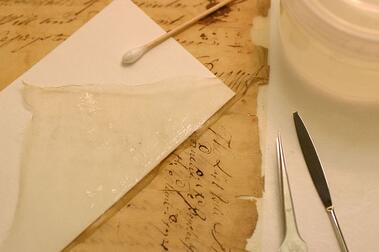Over the years, book conservators have used a wide variety of techniques for preserving, conserving, and repairing rare books. Some of these techniques are more effective than others; indeed, many practices that were commonplace in centuries past actually damaged rare books, rather than protecting them. Contemporary conservators often find themselves having to undo the work of their well-meaning predecessors.

Great Lengths to Protect Rare Books
As collectors know, rare books can be quite susceptible to damage. Pages may get bent or chip; water can warp the books pages and spine; or mildew may grow on books when the humidity and temperature are less than ideal. Conservators have long sought ways to prevent this damage.
One method frequently used in the nineteenth century and early twentieth century was a process called silking. Paper deteriorates over time, especially in warm or wet climates; silking was designed to protect paper from this natural decay. To silk a manuscript, the conservator would first clean the pages. Next, the page is coated with paste and a layer of silk gauze is applied. Sometimes both sides of the leaf were treated this way. The treated page was still legible and ostensibly less likely to incur environmental damage.It soon became evident, however, that silking was not the miracle solution conservators had hoped for. Some silks actually deteriorated faster than the paper itself. Over time it would get brittle or shrink, coming away from the treated page. And silk would also grow discolored over time. Ultimately silking didn't necessarily cause damage to manuscripts, but it didn't really protect them well, either.
Undoing a Conservation Mistake
In many cases, the ill-advised treatments of foregone conservators cannot be undone, and their contemporary counterparts can only strive to prevent further damage. Modern techniques, however, sometimes make it possible for conservators to "de-silk" manuscripts. The painstaking process requires exceptional patience and expertise.
The team at the Morgan Library recently de-silked a valuable edition of A Christmas Carol by Charles Dickens in anticipation of their Dickens at 200 exhibit. Before any treatment began, the book was thoroughly examined and photographed to ensure it would hold up through the treatment. Next, the book was disbound. Each sheet was then submerged in a mixture of alcohol solution and water. The solution dissolved the adhesive used to attach the silk gauze. After the silk was removed, each page was bathed in calcium carbonate-enriched deionized water and alcohol. The conservators gently brushed the pages to remove any leftover adhesive.
Enriching the water with calcium carbonate was an important step; Dickens used black iron-gall ink, which is very acidic and can cause paper to deteriorate. After the pages had been thoroughly washed, they were air dried and placed between blotters to gently flatten. Pages were repaired as needed before the book was rebound. Unlike many authors of his day, Dickens used very high quality paper, a factor that made for a relatively resilient manuscript. The de-silked pages are much closer to their original texture and color.
To watch the de-silking process, watch this video from the Morgan Library.









